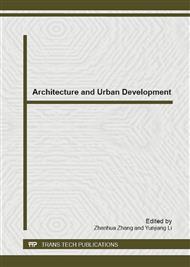[1]
Altar Lee, Cimian Zhu. Concrete random aggregate model generating method of polyhedron (In Chinese): Structural Engineer Vol.27 (2011), pp.23-27.
Google Scholar
[2]
Sun-Myung Kim, Rashid K. Abu AI-Rub. Meso-scale computational modeling of the Plastic-damage reponse of cementitious composites: Cement and Research concrete Vol.41 (2011) ,pp.338-358.
DOI: 10.1016/j.cemconres.2010.12.002
Google Scholar
[3]
Vinh Phu Nguyen, Martijn Stroeven, Lambertus Johannes Sluys. Multiscale failure modeling of concrete: Micromechanical modeling, discontinuous homogenization and parallel computations: Comput. Methods Appl.Mech.Engry.Vol.201-204(2012), pp.139-156.
DOI: 10.1016/j.cma.2011.09.014
Google Scholar
[4]
Weiping Tan, Xinhua Yang, Chuanyao Chen. A fast 3D convex type concrete aggregate random delivery algorithm(In Chinese): Hydroelectric energy Vol.24 (2006), pp.39-41.
Google Scholar
[5]
Xiuli Du, Ruito Da, Yijiang Peng, Yudong Tian. Under the impact load on the compressive strength of concrete meso mechanics numerical simulation (In Chinese): Journal of Beijing University of Technology Vol.35 (2009) ,pp.213-217.
Google Scholar
[6]
Govindjee, S.,Kay, J.G. , and Simo,J.c.[1994], Anisotropic Modeling and Numerical Simulation of Brittle Damage in Concrete: International Journal for Numerical Methods In Engineering Vol.38 (1995), pp.3611-3633
DOI: 10.1002/nme.1620382105
Google Scholar
[7]
Xinwei Tang, Chuhan Zhang. Random aggregate on the hierarchical display method and finite element coordinate generation (In Chinese). Journal of Tsinghua University (NATURAL SCIENCE EDITION) , 2008, 48(12).
Google Scholar
[8]
Guangyan Liu, Zhengguo Gao. Three-dimensional convex concrete aggregate random delivery algorithm (In Chinese): Journal of Tsinghua University (NATURAL SCIENCE EDITION) Vol.43 (2003), pp.1120-1123.
Google Scholar
[9]
Ruijuan Zhang. Study on dynamic mechanical properties of cement mortar: Master thesis. Taiyuan (In Chinese): Taiyuan University of Technology, 2010.
Google Scholar
[10]
Bin Jia, Zhengliang Li, Junlin Tao, Huachuan Yao, fan of concrete SHPB test numerical simulation research (In Chinese): Journal of hydrodynamics, Vol.31(2010),pp.216-222.
Google Scholar
[11]
Xutao Wu, Shanfei Sun, Heping Li. Using HJC constitutive model to simulate the concrete SHPB experiment (In Chinese): Explosion and Shock, Vol.29 (2009), pp.137-142.
Google Scholar


